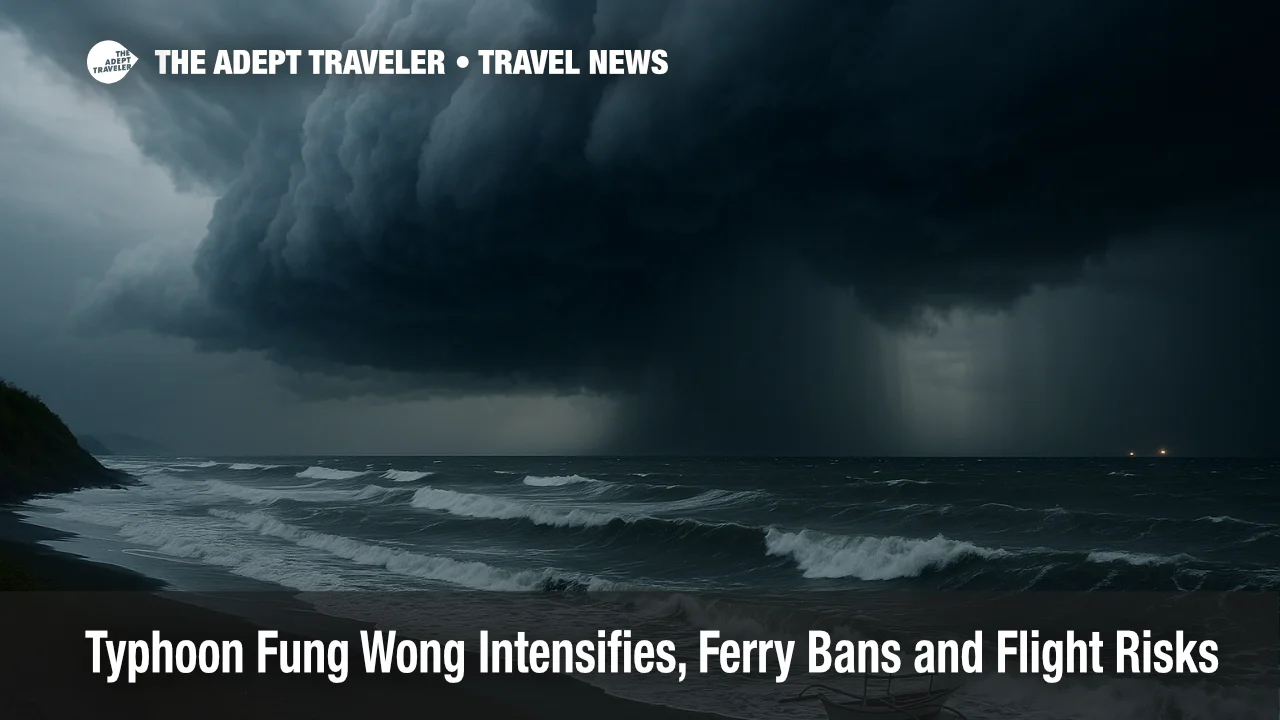Super Typhoon Fung-wong Hits Luzon, Ferries Suspended

Key points
- PAGASA raised Wind Signals up to No. 5 in parts of Aurora and nearby provinces
- Philippine Coast Guard suspends sea travel on multiple corridors with thousands stranded
- Airlines cancel flights and issue waivers as airports in Bicol and Northern Luzon curtail operations
- Travelers via Manila and Clark should add buffer time and track rolling rotation changes
Impact
- Flights
- Expect rolling cancellations and delays as carriers re-time rotations and protect crews across Luzon
- Ferries
- Avoid inter-island ferries on watch corridors until Coast Guard clears sailings and sea states subside
- Airports
- Bicol and select CAAP fields closed or curtailed; Manila and Clark may see holds during peak wind and rain bands
- Timing
- Highest disruption risk through November 10, with residual knock-on delays November 11
- Waivers
- Use airline change waivers to move trips earlier or shift dates without fees where offered
Super Typhoon Fung-wong, locally named Uwan, made landfall over Luzon late Sunday with destructive winds, life-threatening storm surge, and torrential rain. PAGASA placed large areas of Luzon under elevated Tropical Cyclone Wind Signals, ferries were suspended across multiple corridors, and airlines canceled scores of flights. Travelers should avoid sea crossings on affected routes, monitor wind signals by province, and add generous buffers for departures from Manila and Clark as carriers rebuild rotations.
PAGASA wind signals and surge risk
As of the 8:00 p.m. bulletin, PAGASA listed Wind Signal No. 5 for parts of Aurora, with No. 4 and No. 3 expanding across interior Luzon including Metro Manila. The bulletin details specific municipalities under each signal, with Signal No. 5 carrying an extreme threat to life and property, and Signal No. 3 covering Metro Manila, Cavite, Laguna, Batangas, Rizal, Bulacan, Pampanga, Tarlac, Bataan, Zambales, and several Bicol and Calabarzon provinces. PAGASA also warned of a high risk of life-threatening storm surge along wide stretches of Luzon and Visayas coasts.
A Gale Warning is in effect for the seaboards of Luzon, plus the eastern and central seaboards of Visayas, and the eastern seaboards of Mindanao, with seas building up to 14 meters in the worst-affected coastal waters. Under these conditions, small craft and motorbancas should not sail.
Ferries suspended, thousands stranded
The Philippine Coast Guard and port authorities suspended numerous sea trips on Sunday, leaving thousands of passengers, drivers, and vehicles stranded while the storm crossed Luzon. By mid-afternoon, authorities reported over 6,000 stranded across 100 plus ports, and the Philippine Ports Authority published rolling lists of canceled sailings, including Metro Manila and Bataan or Aurora corridors among others. Travelers should assume further suspensions while gale warnings remain in force.
Airport operations and airline moves
Civil aviation authorities closed or curtailed several airports in the storm's path. CAAP reported temporary suspensions in the Bicol and Northern Luzon regions, including timed closures at Cauayan, Baguio, and Sangley, with broader area suspensions across CAAP Area V that covers Bicol. Expect additional tactical closures as crosswinds and rain bands pass.
Manila's Ninoy Aquino International Airport (MNL, local time PHST) and Clark International Airport (CRK) remained operational but with elevated disruption risk as strong bands wrap across Central Luzon. As PAGASA keeps Metro Manila at Wind Signal No. 3 and warns of storm surge for Central Luzon coasts, anticipate ground stops, extended spacing, and de-icing or ramp safety holds during squalls. Build three to six hours of buffer for mid-day and evening banks through Monday, then watch for residual delays Tuesday as aircraft and crews recover.
Airlines moved early on waivers and cancellations. Cebu Pacific issued successive advisories with additional flight cancellations for November 9 and 10. AirAsia Philippines announced a three-option policy, one free date change within 30 days, a two-year credit, or a refund. Philippine Airlines is issuing rolling cancellations and advising customers to check status before heading to the airport. Use these waivers now, inventories will tighten as flights consolidate.
Latest developments
National and international wires reported evacuations in the hundreds of thousands to more than one million as the storm approached and made landfall, with initial fatalities and widespread power outages in the Bicol and Eastern Visayas regions. Government agencies remain on high alert while rescue and damage assessments continue. Travelers should track local advisories for curfews, road closures, and flooding on approaches to airports and ports.
Background
PAGASA's Tropical Cyclone Wind Signal system communicates expected wind intensity and timing for provinces and municipalities, from Signal No. 1 for strong winds to Signal No. 5 for extreme typhoon-force winds. Signals guide preemptive actions by civil aviation, ports, local governments, and utilities. Under Gale Warnings, the Coast Guard typically suspends passenger voyages for motorbancas and many conventional ferries, resuming only when sea states fall below thresholds.
Final thoughts
Super Typhoon Fung-wong is a high-end wind and water event. If you are booked through Manila or Clark, move earlier where possible, keep connections long, and plan alternates. Avoid ferries until the Coast Guard clears sailings and PAGASA winds down signals and surge warnings.
Sources
- PAGASA Tropical Cyclone Bulletin, Super Typhoon Uwan, 8:00 p.m., Nov 9
- GMA, List of canceled sea trips as of Nov 9, 12 p.m.
- Philstar, PCG says more than 6,000 passengers stranded
- CAAP airport closures due to Uwan
- ABS-CBN, Canceled flights for Nov 9-10
- GMA, Canceled flights for Nov 9-10, updated Nov 9
- Cebu Pacific Advisory, additional cancellations Nov 9
- AirAsia Philippines, Uwan cancellations and customer options
- AP News, Super Typhoon Fung-wong makes landfall
- Reuters, Fung-wong nears landfall, evacuations and airport impacts
